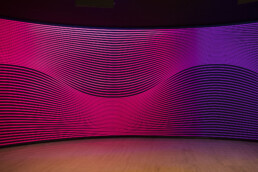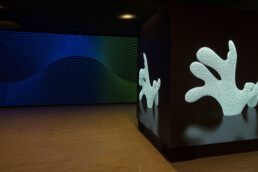Claudia Comte. After Nature
What comes first, day or night? There is no right answer. They are eternally consecutive, as are the elements displayed in the two rooms. A wall painting of a wave breaks through both spaces. First, we find a series of coral-shaped wooden sculptures, leading us on to the obscurity of the ocean’s depths.
Our ways of knowing are shaped by two stars: the moon and the sun. All too often, we think of them as opposites but, actually, they are the very image of non-binary life, one ordered by a movement that blends light into darkness and opens darkness to light: movement and repetition as the source of possibility, regeneration and life. Thus, it is no wonder this exhibition is divided in two chambers: day and night—a room of light and a room of darkness.
However, there is an element that unifies the two worlds, a wall painting, a series of waves that runs from the first space into the second, inviting us to think about the possibility of an infinite visit, a permanent bond between the two elements. Inviting us to the question: What comes first, day or night? There is no right answer. They are eternally consecutive, as are the elements displayed in the two rooms. We do see them as separate, rather they allude to life systems in complete entanglement, in a constant flow of regeneration. And this is what this exhibition is all about: regeneration, the possibility of life, of the re-emergence of life after destruction. This is what every morning is about, and every tide interacting with the moon. We need continuity and we imagine it as a flow, as the result of an organic response surprising us time and time again when we thought nothing more was possible.
Entering the exhibition, we encounter two elements, a beguiling wall painting and a series of coral-shaped wooden sculptures. The corals emerge from the tropical forests of Jamaica, produced mostly from fallen trees. They look soft and their generic shapes already seem familiar and friendly. It is as if we know them already. We wonder if we have encountered them before, perhaps in a comic, a cartoon, or in an advertisement? Their size is also appealing. It is easy to imagine walking towards them and impulsively cuddling one in our arms. They form a family presenting us with their shapes and typologies. They are, somehow, manifesting their ‘‘coral-ness.’’ We have all seen corals before, but these are strange ambassadors of the others, the real ones, which appear to us as stone-like and beautifully-coloured. And now we take notice of them! These ones have no colors. Well, they do, but their color is that of the wood they are made of and bears no resemblance to the hues and tones under the surface of the sea. And yet, they are so eloquent and reliable in their coralness that we do not doubt them.
They could be considered kawaii, the Japanese notion that is often translated into English as “cute.’’ But this cuteness has a strong anthropological function, and a magical one as well. Western culture has never been good at cultivating cuteness and this may explain why, for centuries, we had a hard time relating and finding ways of embracing non-human forms of intelligence. When I was a student, a teacher of mine used to say: “Shakespeare, my dear fellows, was never cute!” We knew what our honourable teacher wanted to say. The themes and forces that shaped the dramas of Shakespeare were rooted in the antagonistic tensions of the binary world, the world that divides the good from the bad, the lovers from the haters, the storms from the calm seas. The development of reason —he thought—needs a continuous struggle with enemies, adversaries, darkness. Not long ago I found myself re-reading A Midsummer Night’s Dream. The play chronicles the adventures of four young Athenian lovers and six amateur actors who are manipulated by the faeries that inhabit the forest in which the play is set. And guess where cuteness emerges! In that very forest! The play revolves around gender reversals; this wonder occurring through the figure of Puck. Puck invents a language for capricious spirits, magical fancy, fun-loving humour, a language of lovely, evocative words that permeate the atmosphere of the play, reaching our senses with a warmth that cannot be resisted. This sensation of not being able to contain our feelings, the sincerity of a sudden attraction to a phenomenon is what the Japanese call kawaii. In Western culture, so keen on describing processes in consecutive stages, the fear of remaining a child forever, or possessing childlike traits as an adult, has negative connotations. But it is this pureness of heart that makes a new order of relations possible between humans and nature, between the human and non-human realms. This radical sincerity of the heart is what I think is present is those coral sculptures.
They encounter us with the same surprise we find upon meeting them. They stand on a mirror that references water. They stand on a mirror because its surface, like the surface of clear water, can reflect the skies and encompass the poetics of impermanence that constitutes their habitat: the winds, the clouds, the ground kneaded by the roots of the plants, the birds and the animals passing. The mirror is there to remind us that those corals were trees and that trees have been constantly affected by the actions of humans. The mirror is also a call for awareness. We see ourselves reflected because it is mostly us—the human species—endangering their existence. Those corals, however, do not bear a negative message. We see our reflection in the mirror and we come together again. In seeing this image, we sense gratitude. Luckily, we are still able to connect. Nihilistic despair about our actions only reinforces a cynical view and disassociates us from our agency and the will to change our behaviour.
— Chus Martínez
→ Download Full Text / Exhibition Brochure
Claudia Comte: After Nature
Curated by Chus Martínez
Museo Nacional Thyssen-Bornemisza
TBA21, Madrid
11 May – 22 August, 2021


